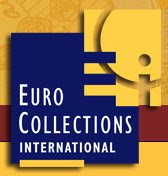
Luxembourg 2009 5€ Chateau de Vianden Silver Niobium BU
The Castle of Vianden is located on the rocks above the town of Vianden and is one of the main tourist attractions of the small (population under 2000) city-status commune town. It was restored only recently and has become a museum which traces its history and its links with the royal families of Europe back to the middle ages. Castle was constructed between the 11th and 14th centuries on the foundations of a Roman 'castellum' and a Carolingian refuge. It is one of the largest and most beautiful feudal residences of the romanesque and gothic periods in Europe.
As mentioned, each coin will feature a core of niobium surrounded by a ring of 92.5% silver. It is not known as yet whether the coins will follow the suit of the Austrian Mint's silver niobium series and issue their niobium in a different colour for each new issue released. The coins are due to be issued on a yearly basis, with 12 coins making up the entire set. Other Castles to be honored in this series are:
- Le château de Beaufort
- Le Château de Bourscheid
- Le Château de Bourglinster
- Le Château de Clervaux
- Le Château d'Esch-sur-Sûre
- Le Château de Larochette
- Le Château de Mersch
- Le Château de Pettingen
- Le Château de Schoenfels
- Le Château de Useldange
- Le château de Vianden
- Le Château de Wiltz
The reverse design features a detailed depiction of the Vianden Castle, perched upon the rocks overlooking the town. Above and to the left is the inscription "Vianden", while at the bottom is the nominal face value of 5 euro. The obverse, shows the common design of the stylised profile portrait of Grand Duke Henri, with the country and year of issue to the left.
The coin is comprised of an outer ring of 92.5% silver and an inner core of niobium, coloured green. The coin measures a total of 34mm in diameter and has a total weight of 16.6 grams and has been struck to brilliant uncirculated standards. It may come as no surprise that the Central Bank of Luxembourg have employed the talents of the Austrian Mint in the creation of these Castle coins, no doubt due to the expert handling of the Austrian Mint's own silver/niobium coin series. Luxembourg is only the second country after Austria to issue a coin series using silver and niobium. They join only a small band of countries to include niobium in any sort of commemorative coin release, making the use of such materials rare and sought after by collectors the world over.
| The Chateau of Vianden silver niobium coin is presented in a stunning, full colour informative coin folder, which beautifully displays the coin at the front of the pack. The folder is housed within a protective outer slipcase. |  |
Euro Collections International currently has stocks of the Luxembourg 2009 5€ Chateau de Vianden Silver Niobium BU available to order now. With such demand for the Austrian Mint's own silver/niobium series we are expecting a great deal of demand for this beautifully crafted Luxembourg series.





2 comments:
I believe Latvia's Coins of Time are also silver-niobium, and also produced by the Austrian mint.
That's true, but I don't really class those two coins as a series, more just as a pair of coins issued 3 years apart. I kind of lump Latvia's Coin of Time issues under the sentence "They (Austria and Luxembourg) join only a small band of countries to include niobium in any sort of commemorative coin release". I also know of British Virgin Islands silver niobium coins with the outer ring in niobium and the inner core in silver, among others. Still, to my knowledge Luxembourg is only the 2nd country to issue (what I would call - being 3 or more in consecutive years) a series of commemoratives in silver and niobium. Thanks for your comment.
Post a Comment